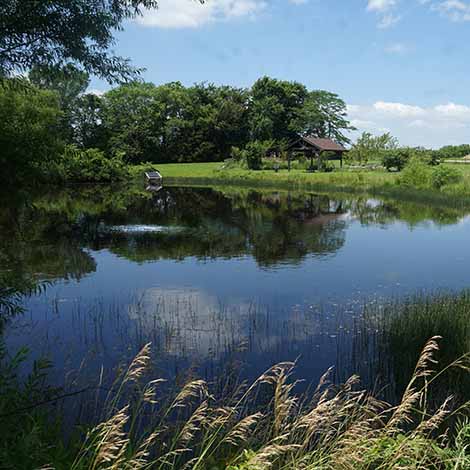As you probably know, proper aeration with an Airmax Aeration System or Fountain (in pond's less than 6' deep) is key to a balanced pond or lake. Proper aeration improves water quality, breaks down organic debris (muck) and improves the overall ecosystem in your pond. Aeration works by circulating the entire pond's water column from top to bottom. The tiny bubbles created by the diffuser forces cool oxygen-deprived water from the bottom depths all the way to the pond's surface. This circulation drives oxygen to the bottom of the pond allowing "good" bacteria to digest muck, reducing nutrients and increasing the overall dissolved oxygen in the pond.
Spring-Fed or Under Aerated
A spring-fed pond is fed by a spring or groundwater, which keeps the pond full. As the freshwater flows into the lake or pond from the underground aquifer, the water does move somewhat. But it doesn't keep it agitated enough to naturally aerate it and maintain good water quality. Have you ever swam in your pond and felt very cold water at your feet? Many pond owners believe these cold zones indicate a spring-fed pond. In reality, it is likely caused by a thermocline, or the separation of water layers based on temperature, indicating aeration is needed or is undersized.
In addition to the creation of thermoclines, a system that is undersized will not create uniform circulation and simply pump small amounts of the cool nutrient-rich water from the bottom of your pond to the top. This is the equivalent of adding fertilizer to your pond. This can result in additional algae growth, odors and even fish kills. This can all be especially true during the warmer months of the year.
Test Your Pond's Temperature
If you think your aerator isn't doing its job, it's easy to diagnose: Just take your pond's temperature! Recording temperature readings from various areas and depths of the pond to help determine if you are correct.
- To begin, you'll need a non-floating pond thermometer, a long string, a tape measure, a waterproof marker, a stopwatch or watch, and a pad of paper and pencil. Tie the string to your thermometer, and measure and mark every 24 inches down the length of the string with your waterproof marker.
- Once your tools are set up, gather them together, hop in your boat and motor to various locations in your pond.
- At each spot, noting where you are, drop the thermometer into the water and take the water's temperature readings 24 inches down at a time, from the top to the bottom. Let the thermometer rest long enough (5 to 10 minutes) to get the true temperature reading at your desired depth.
- Repeat this process in different areas (particularly if your lake is unevenly shaped), taking notes all along the way.
Once you're done taking your lake's temperature, look at your notes. Are there more than a few degrees difference in any of your temperature readings? If so, you're more than likely under-aerating your pond.
The good news is that The Pond Guy offers a Free Aerial Mapping Service. We can help measure your pond and tell you where the diffusers should be placed so that you're getting even aeration throughout the body of water. Your fish will thank you for it!

